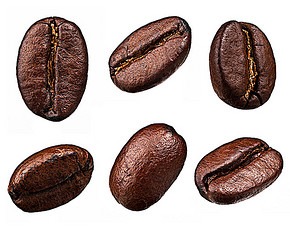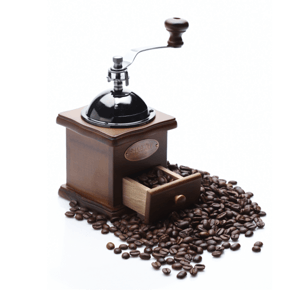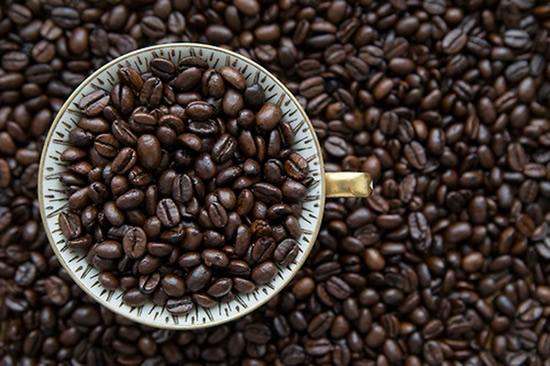What's the tasty Robusta like?
Follow the caf é (Wechat official account vdailycom) and found that Beautiful Cafe opened a small shop of its own.
Coffee can be roughly divided into two varieties, Arabica and Robusta. Of the coffee cultivated worldwide, 60% to 70% is Arabica, which has excellent flavor and aroma, and is the only coffee that can be drunk directly. We can often see canned coffee marked "100% Arabica", but precisely because it emphasizes the use of 100% Arabica, it is a self-confession, which actually proves on the other hand how little 100% Arabica canned coffee should be.

So what kind of coffee is used for canned coffee that is not 100% Arabica? It uses a certain proportion of robusta coffee, that is, a mixture of Arabica and robusta coffee.
When we talk about the robusta species, the exact botanical term is the Congo species (scientific name: Coffee Canephora), and the Robsta species is one of the varieties of the Congo species. However, in Japan, it is commonly known as the Robbata species, which is regarded as synonymous with the Congolese species. Therefore, this book uses the familiar Robbata species or Robsta species to express.
Take a sip of 100% Robusta coffee and you will immediately know that it tastes astringent and terrible. It emits a smell called "Luobu", similar to the smell of burnt wheat, not only with a strong bitter taste, but also with a fishy smell and moldy smell. Therefore, it is not difficult to understand why it is used as an "increment" in canned coffee, instant coffee and poor-quality ordinary coffee.
Robusta was once rated as "worse than the lowest Brazilian Santos coffee". Although it can't be drunk directly, it will have a corresponding effect if mixed with Arabica. Although the sour and sweet taste is inferior to Arabica, its high concentration and strong bitterness are indispensable varieties of coffee for the above-mentioned industries. Moreover, Robusta also has strong disease resistance. It is highly resistant to leaf rust, the archenemy of coffee.
On the contrary, although Arabica has a good taste and aroma, it is weak in resistance to frost, diseases and insect pests. Airborne leaf rust once raged in India and Ceylon (now Sri Lanka), causing devastating disasters. This is why India and Ceylon have changed from big coffee producers to black tea kingdoms.
Important Notice :
前街咖啡 FrontStreet Coffee has moved to new addredd:
FrontStreet Coffee Address: 315,Donghua East Road,GuangZhou
Tel:020 38364473
- Prev

Where is the origin of Robusta coffee?
Follow Cafe (Wechat official account vdailycom) found that Beautiful Cafe opened its own small shop, Robusta Coffee, also known as Big Leaf Coffee, native to the African Congo, disease-resistant, insect-resistant, low-temperature tolerance, easy to grow lowland coffee, taste bitter but not sour, suitable for making mixed coffee, accounting for 30% of the world's output has been widely cultivated in recent years. Robusta species
- Next

Description of taste and flavor of Sidamo coffee beans
Following Cafe Review (Wechat official account vdailycom) found that Cafe Beautiful Cafe opened a small shop of its own, Sidamo Coffee has a very diverse coffee flavor. Different soil types, microclimates and countless native coffee species, towering mountains, highlands, plateaus, valleys and plains, diverse topography, and the geology of the area belongs to fertile and well-drained volcanic soil.
Related
- Detailed explanation of Jadeite planting Land in Panamanian Jadeite Manor introduction to the grading system of Jadeite competitive bidding, Red bid, Green bid and Rose Summer
- Story of Coffee planting in Brenka region of Costa Rica Stonehenge Manor anaerobic heavy honey treatment of flavor mouth
- What's on the barrel of Blue Mountain Coffee beans?
- Can American coffee also pull flowers? How to use hot American style to pull out a good-looking pattern?
- Can you make a cold extract with coffee beans? What is the right proportion for cold-extracted coffee formula?
- Indonesian PWN Gold Mandrine Coffee Origin Features Flavor How to Chong? Mandolin coffee is American.
- A brief introduction to the flavor characteristics of Brazilian yellow bourbon coffee beans
- What is the effect of different water quality on the flavor of cold-extracted coffee? What kind of water is best for brewing coffee?
- Why do you think of Rose Summer whenever you mention Panamanian coffee?
- Introduction to the characteristics of authentic blue mountain coffee bean producing areas? What is the CIB Coffee Authority in Jamaica?

